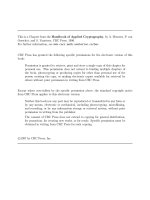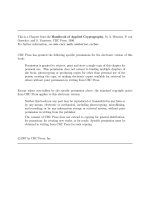Handbook of biodegradable Polymers - Preface
Bạn đang xem bản rút gọn của tài liệu. Xem và tải ngay bản đầy đủ của tài liệu tại đây (64.44 KB, 6 trang )
XV
Preface
Degradable polyesters with valuable material properties were pioneered by
Carothers at DuPont by utilizing ring - opening polymerization approaches for
achieving high molecular weight aliphatic poly(lactic acid)s in the 1930s. As a
result of various oil crises, biotechnologically produced poly(hydroxy alkanoates)
were keenly investigated as greener, non - fossil fuel based alternatives to petro-
chemical based commodity plastics from the 1960s onwards. Shortly afterwards,
the fi rst copolyesters were utilized as slowly drug releasing matrices and surgical
sutures in the medical fi eld. In the latter half of the 20th century, biodegradable
polymers developed into a core fi eld involving different scientifi c disciplines such
that these materials are now an integral part of our everyday lives. This fi eld still
remains a hotbed of innovation today. There is a burning interest in the use of
biodegradable materials in clinical settings. Perusal of the literature will quickly
reveal that such materials are the backbone of modern, biomaterial - based
approaches in regenerative medicine. Equally, this technology is central to current
drug delivery research through biodegradable nanocarriers, microparticles, and
erodible implants, which enable sophisticated controlled drug release and target-
ing. Due to the long historic legacy of polymer research, this fi eld has been able
to develop to a point where material compositions and properties can be refi ned
to meet desired, complex requirements. This enables the creation of a highly
versatile set of materials as a key component of new technologies. This collected
series of texts, written by experts, has been put together to showcase the state of
the art in this ever - evolving area of science.
The chapters have been divided into three groups with different themes.
Chapters 1 – 8 introduce specifi c materials and cover the major classes of polymers
that are currently explored or utilized. Chapters 9 – 14 describe applications of
biodegradable polymers, emphasizing the exciting potential of these materials. In
the fi nal chapters, 15 – 16 , characterization methods and modelling techniques of
biodegradation processes are depicted.
Materials: Lendlein et al. , then Ienczak and Arag ã o, start with up - to - date reviews
of the seminal polyesters and biotechnologically produced polyesters, respectively.
Other chapters concern polymers with different scission moieties and behaviors.
Domb et al. provide a comprehensive review of polyanhydrides, which is followed
by an excellent overview of poly(ortho esters) contributed by Heller. Amino
XVI
Preface
acid - based materials and degradable polyurethanes make up the subject of the
next two chapters by Katsarava and Gomurashvili, then Puiggali et al. , respectively.
Synthetic polysaccharides, which are related to many naturally occurring biopoly-
mers, are then described at length by Dumitriu, Dr ä ger et al. To conclude the
individual polymer - class section, biodegradable polyolefi ns, which are degraded
oxidatively, and are intended as degradable commodity plastics, are covered by
Wiles et al.
Applications: The two chapters by Ikada and Shakesheff give a critical update on
the status of biodegradable materials applied in regenerative therapy and then in
drug delivery systems. From there, further exciting applications are described;
shape - memory polymers and their potential as implant materials in minimally
invasive surgery are discussed by Lendlein et al. ; Huh et al. highlight the impor-
tance of biodegradable hydrogels for tissue expander applications; Franke et al.
cover how implants can be used to aid regenerative treatment of mucosal defects
in surgery; Khandare and Kumar review the relevance of biodegradable dendrim-
ers and dendritic polymers to the medical fi eld.
Methods: Van der Zee gives a description of the methods used to quantify bio-
degradability and the implications of biodegradability as a whole; Watanabe and
Kawai go on to explain methods used to explore degradation through modelling
and simulations.
The aim of this handbook is to provide a reference guide for anyone practising
in the exploration or use of biodegradable materials. At the same time, each
chapter can be regarded as a stand alone work, which should be of great benefi t
to readers interested in each specifi c fi eld. Synthetic considerations, physical prop-
erties, and erosion behaviours for each of the major classes of materials are dis-
cussed. Likewise, the most up to date innovations and applications are covered in
depth. It is possible upon delving into the provided information to really gain a
comprehensive understanding of the importance and development of this fi eld
into what it is today and what it can become in the future.
We wish to thank all of the participating authors for their excellent contributions
towards such a comprehensive work. We would particularly like to pay tribute to
two very special authors who sadly passed away during the production time of
this handbook. Jorge Heller was a giant in the biomaterials fi eld and pioneered
the fi eld of poly(ortho esters). Severian Dimitriu is well known for his series of
books on biodegradable materials, which served to inspire and educate countless
scientists in this area. Our sincerest thanks go to Gloria Heller and Daniela
Dumitriu for their cooperation in completing these chapters. We also acknowledge
the untiring administrative support of Karolin Schm ä lzlin, Sabine Benner and
Michael Schroeter, and the expert cooperation from the publishers at Wiley, espe-
cially Elke Maase and Heike N ö the.
Andreas Lendlein
Adam Sisson
Teltow, September 2010
XVII
List of Contributors
Gl á ucia Maria Falc ã o de Arag ã o
Federal University of Santa Catarina
Chemical and Food Engineering
Department
Florian ó polis, SC 88040 - 900
Brazil
Marc Behl
Center for Biomaterial Development,
Institute of Polymer Research
Helmholtz - Zentrum Geesthacht
Kantstr. 55
14513 Teltow
Germany
Emo Chiellini
University of Pisa
Department of Chemistry and
Industrial Chemistry
via Risorgimento 35
Pisa 56126
Italy
Andrea Corti
University of Pisa
Department of Chemistry and
Industrial Chemistry
via Risorgimento 35
Pisa 56126
Italy
Salvatore D ’ Antone
University of Pisa
Department of Chemistry and
Industrial Chemistry
via Risorgimento 35
Pisa 56126
Italy
Avi Domb
Hebrew University
School of Pharmacy
Department of Medicinal Chemistry
Jerusalem 91120
Israel
Gerald Dr ä ger
Gottfried Wilhelm Leibniz Universit ä t
Hannover
Institut f ü r Organische Chemie
Schneiderberg 1B
30167 Hannover
Germany
Severian Dumitriu
t
University of Sherbrooke
Department of Chemical Engineering
2400 Boulevard de l ′ Universit é
Sherbrooke, Quebec J1K 2R1
Canada
XVIII
List of Contributors
Zaza Gomurashvili
PEA Technologies
709 Mockingbird Cr.
Escondido, CA 92025
USA
Jorge Heller
t
PO Box 3519, Ashland, OR 97520
USA
Bernhard Hiebl
Centre for Biomaterial Development
and Berlin - Brandenburg Centre for
Regenerative Therapies (BCRT)
Institute of Polymer Research
Helmholtz - Zentrum Geesthacht
Kantstr. 55
14513 Teltow
Germany
Kang Moo Huh
Chungnam National University
Department of Polymer Science and
Engineering
Daejeon 305 - 764
South Korea
Jaciane Lutz Ienczak
Federal University of Santa Catarina
Chemical and Food Engineering
Department
Florian ó polis, SC 88040 - 900
Brazil
Yoshito Ikada
Nara Medical University
Shijo - cho 840
Kashihara - shi
Nara 634 - 8521
Japan
Lourdes Franco
Universitat Polit è cnica de Catalunya
Departament d ’ Enginyeria Qu í mica
Av. Diagonal 647
08028 Barcelona
Spain
Ralf - Peter Franke
Centre for Biomaterial Development
and Berlin - Brandenburg Centre for
Regenerative Therapies (BCRT)
Institute of Polymer Research
Helmholtz - Zentrum Geesthacht
GmbH
Kantstr. 55
14513 Teltow
Germany
and
University of Ulm
Central Institute for Biomedical
Engineering
Department of Biomaterials
89069 Ulm
Germany
Yourong Fu
Akina, Inc.
West Lafayette, IN 47906
USA
Rosemarie Fuhrmann
University of Ulm
Central Institute for Biomedical
Engineering
Department of Biomaterials
89069 Ulm
Germany
John Garner
Akina, Inc.
West Lafayette, IN 47906
USA
List of Contributors
XIX
Jay Prakash Jain
National Institute of Pharmaceutical
Education and Research (NIPER)
Department of Pharmaceutics
Sector 67
S.A.S. Nagar (Mohali) 160062
India
Friedrich Jung
Centre for Biomaterial Development
and Berlin - Brandenburg Centre for
Regenerative Therapies (BCRT)
Institute of Polymer Research
Helmholtz - Zentrum Geesthacht
Kantstr. 55
14513 Teltow
Germany
Ramaz Katsarava
Iv. Javakhishvili Tbilisi State
University
Institute of Medical Polymers and
Materials
1, Chavchavadze ave.
Tbilisi 0179
Georgia
and
Georgian Technical University
Centre for Medical Polymers and
Biomaterials
77, Kostava str.
Tbilisi 75
Georgia
Fusako Kawai
Kyoto Institute of Technology
Center for Nanomaterials and Devices
Matsugasaki
Sakyo - ku, Kyoto 606 - 8585
Japan
Jayant Khandare
Piramal Life Sciences Ltd.
Polymer Chem. Grp
1 Nirlon Complex
Off Western Express Highway
Goregaon (E), Mumbai 400063
India
Andreas Krause
Gottfried Wilhelm Leibniz Universit ä t
Hannover
Institut f ü r Organische Chemie
Schneiderberg 1B
30167 Hannover
Germany
Neeraj Kumar
National Institute of Pharmaceutical
Education and Research (NIPER)
Department of Pharmaceutics
Sector 67
S.A.S. Nagar (Mohali) 160062
India
Sanjay Kumar
Piramal Life Sciences Ltd.
Polymer Chem. Grp
1 Nirlon Complex
Off Western Express Highway
Goregaon (E), Mumbai 400063
India
Andreas Lendlein
Center for Biomaterial Development
and Berlin - Brandenburg Center for
Regenerative Therapies, Institute of
Polymer Research
Helmholtz - Zemtrum Geesthacht
Kantstr. 55
14513 Teltow
Germany









